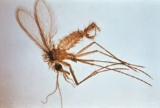
Phlebotomus
Encyclopedia
Phlebotomus is a genus
of "sand fly" in the Dipteran family Psychodidae
. In the past, they have sometimes been considered to belong in a separate family, Phlebotomidae, but this alternative classification has not gained wide acceptance.
, Phlebotomus sand flies are primarily responsible for the transmission of leishmaniasis
, an important parasitic disease, while transmission in the New World
, is generally via sand flies of the genus Lutzomyia
. The protozoa
n parasite itself is a species of the genus Leishmania
. Leishmaniasis normally finds a mammalian reservoir in rodents and other small animals such as canids (Canine leishmaniasis
) and hyraxes. The female sand fly carries the Leishmania protozoa from infected animals after feeding, thus transmitting the disease, while the male feeds on plant nectar.
Phlebotomus species are also vectors for bartonellosis
, verruga peruana
, pappataci fever
, an arbovirus
caused by Sandfly fever viruses such as Naples and Sicilian strains, which are members of the genus Phlebovirus
(family Bunyaviridae
), which also includes the closely related Toscana virus.
In Egypt there are two species of medical importance Phlebotomus papatasii and Phlebotomus langerni. These flies are short lived. Females are blood suckers at night, males feed on plant juices. Adults are poor fliers, they usually hop for short distances.
Males possess long prominent genital terminalia known as claspers.
Females have a pair of anal recti.
Genus
In biology, a genus is a low-level taxonomic rank used in the biological classification of living and fossil organisms, which is an example of definition by genus and differentia...
of "sand fly" in the Dipteran family Psychodidae
Psychodidae
The nematoceran family Psychodidae are small true flies with short, hairy bodies and wings giving them a "furry" moth-like appearance...
. In the past, they have sometimes been considered to belong in a separate family, Phlebotomidae, but this alternative classification has not gained wide acceptance.
Epidemiology
In the Old WorldOld World
The Old World consists of those parts of the world known to classical antiquity and the European Middle Ages. It is used in the context of, and contrast with, the "New World" ....
, Phlebotomus sand flies are primarily responsible for the transmission of leishmaniasis
Leishmaniasis
Leishmaniasis is a disease caused by protozoan parasites that belong to the genus Leishmania and is transmitted by the bite of certain species of sand fly...
, an important parasitic disease, while transmission in the New World
New World
The New World is one of the names used for the Western Hemisphere, specifically America and sometimes Oceania . The term originated in the late 15th century, when America had been recently discovered by European explorers, expanding the geographical horizon of the people of the European middle...
, is generally via sand flies of the genus Lutzomyia
Lutzomyia
Lutzomyia is a genus of "sand flies" in the Psychodidae subfamily Phlebotominae and in the order Diptera. In the New World, Lutzomyia sand flies are responsible for the transmission of leishmaniasis, an important parasitic disease and Carrion's disease. Leishmaniasis is generally transmitted in...
. The protozoa
Protozoa
Protozoa are a diverse group of single-cells eukaryotic organisms, many of which are motile. Throughout history, protozoa have been defined as single-cell protists with animal-like behavior, e.g., movement...
n parasite itself is a species of the genus Leishmania
Leishmania
Leishmania is a genus of Trypanosomatid protozoa, and is the parasite responsible for the disease leishmaniasis. It is spread through sandflies of the genus Phlebotomus in the Old World, and of the genus Lutzomyia in the New World. Their primary hosts are vertebrates; Leishmania commonly infects...
. Leishmaniasis normally finds a mammalian reservoir in rodents and other small animals such as canids (Canine leishmaniasis
Canine Leishmaniasis
Canine leishmaniasis is a zoonotic disease caused by Leishmania parasites transmitted by the bite of an infected Phlebotomine sandfly. Canine leishmaniasis was first identified in Europe in 1903, and in 1940 it was determined that 40% of all dogs in Rome were positive for leishmaniasis...
) and hyraxes. The female sand fly carries the Leishmania protozoa from infected animals after feeding, thus transmitting the disease, while the male feeds on plant nectar.
Phlebotomus species are also vectors for bartonellosis
Bartonellosis
Bartonellosis is an infectious disease produced by bacteria of the genus Bartonella. Bartonella species cause diseases such as Carrión´s disease, trench fever, and cat scratch disease, and other recognized diseases, such as bacillary angiomatosis, peliosis hepatis, chronic bacteremia, endocarditis,...
, verruga peruana
Verruga peruana
Verruga peruana is the chronic delayed stage of infection by Bartonella bacilliformis....
, pappataci fever
Pappataci fever
Pappataci fever is a vector-borne febrile arboviral infection caused by three serotypes of Phlebovirus. Occurs in subtropical regions of the Eastern Hemisphere...
, an arbovirus
Arbovirus
Arbovirus is a term used to refer to a group of viruses that are transmitted by arthropod vectors. The word arbovirus is an acronym . Some arboviruses are able to cause emergent disease.-Transmission:...
caused by Sandfly fever viruses such as Naples and Sicilian strains, which are members of the genus Phlebovirus
Phleboviruses
Phlebovirus is one of five genera of the family Bunyaviridae. The Phlebovirus genus currently comprises over 70 antigenically distinct serotypes, only a few of which have been studied...
(family Bunyaviridae
Bunyaviridae
Bunyaviridae is a family of negative-stranded RNA viruses. Though generally found in arthropods or rodents, certain viruses in this family occasionally infect humans. Some of them also infect plants....
), which also includes the closely related Toscana virus.
In Egypt there are two species of medical importance Phlebotomus papatasii and Phlebotomus langerni. These flies are short lived. Females are blood suckers at night, males feed on plant juices. Adults are poor fliers, they usually hop for short distances.
Morphology
Adults are small sized about 1.5–3 mm, yellowish in colour with conspicuous black eyes, hairy body, wings and legs. The oval lanceolate wings are carried erect on the humped thorax.Males possess long prominent genital terminalia known as claspers.
Females have a pair of anal recti.

